There is actually an arrest warrant against Russia’s President Vladimir Putin from the International Criminal Court. The handcuffs should have clicked during his most recent state visit to Mongolia. Instead, head of state Ukhnaagiin Khürelsükh rolled out a red carpet for his powerful neighbor in Ulaanbaatar. And Putin visibly enjoyed walking across it. A signal to the world that he is not isolated.
However, apart from this small satisfaction, Putin’s visit to Mongolia was not a success, as Michael Radunski writes in his analysis. After all, Putin came to Ulaanbaatar to finally get a commitment from the small neighboring country for his mammoth “Power of Siberia 2” project, a gas pipeline from Russia through Mongolia to China. However, Mongolia is cautious and does not want to increase its dependence on Russia further. And China is also not playing along as hoped: Beijing wants steep discounts on Russian gas.
The one-child policy has been successful, but with an effect that is unlikely to please Beijing. Calculations suggest that China’s population will have halved by the end of the century. What has already largely disappeared is the extended family, once an important bond in society. Even today, young people no longer know how to address distant relatives correctly at family gatherings, writes Johnny Erling in his column. The Chinese language has its own word for every relative: Apps help with the linguistic subtleties.

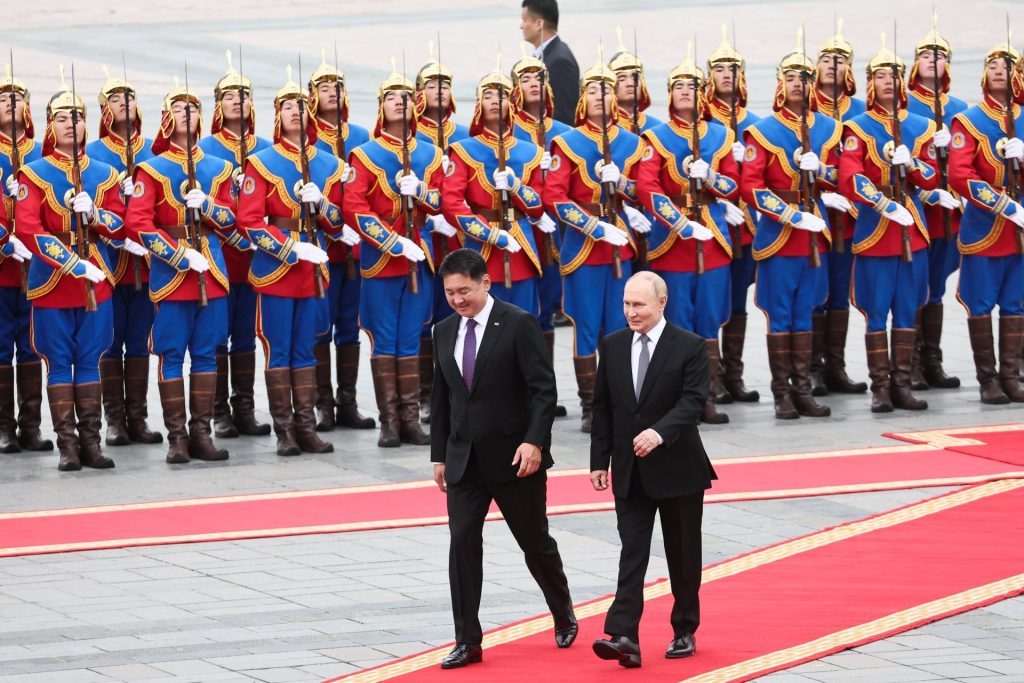
Vladimir Putin’s visit to Mongolia caused considerable furor. Anger spread, especially in the Western media: “No Arrest, but a Guard of Honor for Putin” was one of the headlines. The reason for this is the arrest warrant against Russia’s president issued by the International Criminal Court (ICC) – and the Mongolian head of state Ukhnaagiin Khürelsükh should actually have had Putin arrested.
All of this is true. Yet the fact that the Russian president’s visit to Mongolia was a substantive failure is being overlooked. Putin’s primary goal in Ulaanbaatar was to advance his enormous “Power of Siberia 2” project, a gas pipeline from Russia via Mongolia to China. However, it failed completely. Mongolia is growing increasingly skeptical about the gas pipeline. And in the background, China is demanding steep price reductions.
In Ulaanbaatar, Putin campaigned extensively for the pipeline: He said that the “Power of Siberia 2” was by no means just about the transit of Russian gas through Mongolia. “We are discussing the potential delivery of gas to Mongolian consumers,” said Putin, according to Kremlin sources – and promised that the Russian company Gazprom was ready to provide the necessary support to connect Mongolian consumers to the gas supply system.
A very tempting offer for Mongolia. The democracy in the Far East is geographically wedged between the autocratic superpowers of Russia and China. Without its own access to the sea, Mongolia’s dependence is almost overwhelming: 98 percent of its energy comes from Russia, while 90 percent of its exports go to China.
And yet, head of state Uchnaagiin Chüreslsüch turned down the Russian offer. “Mongolia has probably realized that this is a poisoned gift from Moscow,” Viktor Frank told Table.Briefings. At the start of the project, the mood was much more positive. “But since the war in Ukraine, the mood has changed. People don’t want to increase their dependence on Russia any further,” explains the head of the Konrad Adenauer Foundation’s office in Ulaanbaatar.
Putin urgently needs success with the “Power of Siberia 2.” Since the Russian invasion of Ukraine and the Western sanctions, Gazprom has had particular problems selling its gas. After the gas company reliably flushed billions into the Kremlin’s coffers, it is suddenly in the red – for the first time since 1999. Last year closed with a record loss of almost 6.4 billion euros.
It needs new buyers. And Putin actually has a plan: The gas that Gazprom used to sell profitably in Europe is supposed to go to China – via the “Power of Siberia 2.” At a cost of around 100 billion euros, the 2,600-kilometer-long pipeline will transport 50 billion cubic meters of natural gas per year from the Yamal Peninsula in the north of Russia via Mongolia to China. Everything could fit perfectly: China’s hunger for energy is enormous. On top of this, the country is currently closer to Russia in its “boundless friendship” against the West than almost ever before in history.
But while Mongolia is increasingly skeptical about the project, China is now also limiting this friendship – over money. Beijing wants to pay the same price for Russian gas as Gazprom charges on the domestic market. Gas is significantly cheaper for Russian customers because it is massively subsidized by the state.
Another fact shows just how unfriendly Beijing’s demands are: China is already paying significantly less for Russian natural gas than Gazprom was previously able to demand from European customers such as Germany. Li Lifan, an expert on Russia and Central Asia at the Shanghai Academy of Social Sciences, explains China’s position in the South China Morning Post as follows: “Mongolia hopes to get investment from China and Russia, [but] Russia does not have the money and China is not in a rush to build the pipeline.” Viktor Frank from the KAS in Ulaanbaatar is also convinced: “The decisive factor is China. If Beijing gives the go-ahead, the pipeline will be built.”
In any case, Mongolia has already drawn the consequences. The ruling government coalition has removed the “Power of Siberia 2” from its action program for the next four years. And so Putin’s supposed diplomatic success in Ulaanbaatar is fading very quickly.
And about the arrest warrant? It’s true: Since March 2023, the International Criminal Court (ICC) has issued an arrest warrant for Russia’s president. Since Mongolia has ratified the Rome Statute of the ICC, the Mongolian head of state should have had Putin arrested. That did not happen, and Putin clearly enjoyed showing the West in Ulaanbaatar that he is by no means as isolated as they would like him to be. But that was about the only thing he achieved in Mongolia.
Sept. 16, 2024; 3 p.m. CEST (9 a.m. Beijing time)
Center for Strategic and International Studies, online seminar: A New Cold War? Congressional Rhetoric and Regional Reactions to the U.S.-China Rivalry More
Sept. 17, 2024; 11 a.m. CEST (5 p.m. Beijing time)
Sino-German Center Frankfurt School, Virtual Roundtable: Development and Future of Corporate Venture Capital in China More
ept. 18, 2024; 7 p.m. CEST
Merics and Young China Watchers, Seminar with personal invitation (in Berlin): Oxford-style Debate: Be careful what you wish for! Trump or Harris – Who is better for European China Policy? More
Sept 19-28, 2024
AHK China, Radisson Collection Hotel, Event (in Shanghai): 25th Shanghai Oktoberfest More
Sept. 20, 2024; 8:30 a.m. Beijing time
AHK China, lecture and networking event (in Beijing): Sino-German Automotive Forum: Driving The Green Transformation More
Showdown on additional EV tariffs: China’s Minister of Commerce Wang Wentao will visit Brussels next week. The Chinese Ministry of Commerce announced on Thursday that Wang will meet EU Trade Commissioner Valdis Dombrovskis next Thursday to discuss the tariffs.
The decision on whether the additional tariffs on Chinese EVs will apply for five years from November will be made in the coming weeks – but the rift between the EU states is becoming clearer. Spain’s Prime Minister Pedro Sánchez spoke out against the tariffs during his visit to Beijing this week and German Chancellor Olaf Scholz expressed a similar sentiment.
At the upcoming binding vote in the EU Council, 15 of the 27 member governments, representing 65 percent of the population, would have to vote against the tariffs to prevent them from coming into force for five years as planned. In a preliminary vote in July, Spain had still voted in favor of the tariffs – but Beijing’s subsequent threat to impose anti-dumping duties on pork apparently had an effect on Spain, the EU’s largest producer.
Germany and several other member states had abstained. It remains to be seen whether Spain will actually vote against the tariffs. However, if this is the case, there is still a long way to go before the tariffs are stopped, according to the Council’s assessment. Several populous member states would have to switch to the camp opposed to the tariffs. ari/mgr
German Environment Minister Steffi Lemke has announced at a hearing in the Bundestag’s Environment Committee that the projects involving climate certificate fraud in China will be reversed. Wherever possible under administrative law, the damage caused to the climate must be compensated, Lemke explained at a special session of the Bundestag’s Environment Committee on Wednesday, according to a report by the agricultural service Agra.
According to a report by the Ministry of the Environment, reversing incorrect projects is associated with high legal hurdles, but has already occurred in one case. Lemke testified before the Committee at the request of the CDU/CSU parliamentary group. Members of the CDU/CSU accused Lemke of taking too long to uncover the irregularities.
According to Agra, Lemke stated that her ministry had discontinued the fraud-prone system as of July 1. New applications have not been accepted. On Friday, the Federal Environment Agency (UBA) announced that it had stopped eight so-called Upstream Emission Reduction (UER) projects in China. Several large, internationally active companies had applied for these certificates. They wanted to use them to offset carbon reduction measures in China in order to fulfill their emission quotas. The UBA is currently investigating other projects in China and around the world. According to Lemke, investigations are also underway against German companies allegedly involved in certifying the halted projects. ck
The Chinese Ministry of Commerce has warned the country’s car manufacturers of the risks of investing in foreign automotive markets. At an industry meeting in early July, ministry representatives “strongly advised” local car manufacturers against investing in India, Russia and Turkey, referring to a central government directive, Reuters reported, citing anonymous sources. They also classified the construction of factories in Europe and Thailand as risky, albeit less strongly.
It was said that overseas factories should primarily use components exported from China for the final assembly of vehicles. This would minimize potential risks due to geopolitical problems. Chinese car manufacturers increasingly aim to expand abroad as they struggle with a worsening overcapacity problem.
The presence of Chinese car brands has increased in Russia since Western car manufacturers withdrew due to the war in Ukraine. Chery is currently in talks with Russian manufacturers about local car production, as the state news agency TASS reported in August, citing Vladimir Shmakov, the director of Chery’s Russian subsidiary.
Several European countries, including Spain and Italy, are also trying to attract investment from Chinese car manufacturers. However, Chinese companies remain cautious. Independent local production requires significant investment and a deep understanding of local laws and culture. Nevertheless, Volvo owner Geely is already sounding out locations for a plant in Europe, but has not yet fully committed to setting up local production, according to executives.
Other companies, such as Leapmotor, have opted for a partnership with local firms. This year, Leapmotor’s joint venture with Stellantis began producing electric vehicles at the French-Italian car manufacturer’s Polish plant. rtr

For a long time, the People’s Republic was proud of two unique characteristics: Being the world’s most populous nation and, since 1980, the first country with a population of one billion. However, India caught up with China and overtook it in 2022. Not only do more people live there today, but they are also younger – by ten years on average. By the end of this century, China may no longer be a nation of billions.
Since Tourists are finally allowed to visit the People’s Republic after the pandemic, they gush about the vital society in a modern state that owns the 21st century when they return home. They ignore a reality that Beijing itself calls its second “new norm”: A persistent economic and consumer slump, young people’s fears about the future and a rapidly aging society.
The causes are not only the economic problems exacerbated by the pandemic, but also the long-term consequences of a one-child policy that was enforced for decades. On closer inspection, the outwardly dynamic Middle Kingdom is a gigantic empire of the elderly. In September, its Ministry of Civil Affairs revealed that by the end of 2023, one in five Chinese citizens will be over the official retirement age. In numbers: Around 297 million of the 1.4 billion Chinese will be over 60 by then, including 215 million over 65.
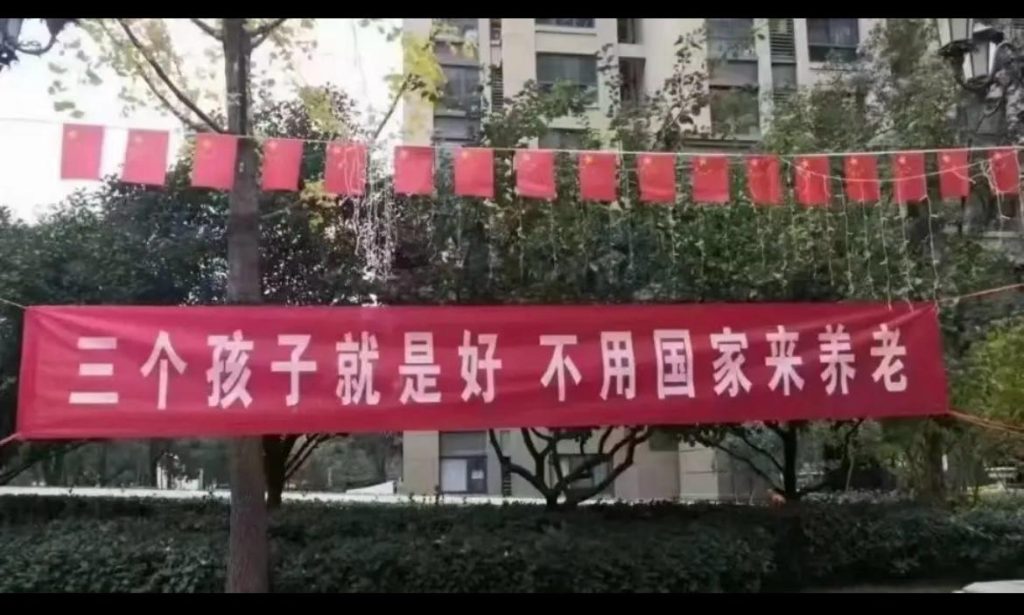
60-year-olds comprise well over 21 percent of the population and 65-year-olds over 15.4 percent. This means that the People’s Republic has made another quantum leap, albeit an unintentional one this time: Catching up with developed countries such as the USA, Europe, Japan or South Korea in terms of population age. According to the UN definition, China falls into the category of a “moderately aged society,” with 15 percent over the age of 65. While it took Europe decades and the USA 66 years to achieve this, the People’s Republic did it in just 25 years.
With its inadequate social security systems and its glaring rich-poor and rural-urban divide, the country is not prepared for this. First, it would have to raise its retirement age, which is currently 60 for men and 50 or 55 for women. The corresponding plan will be on the next People’s Congress agenda. China had set the current retirement age in the Labor Law of 1951, at a time when life expectancy was 43 years. Today, life expectancy is 78.6 years, thanks to improved living conditions during the reform period and advances in nutrition and medicine.
This success has a downside: China’s underfunded pension funds will be empty by 2035, as Beijing economists have repeatedly warned since 2019. Party leader Xi Jinping has set the year 2035 as his target to prove to the world that his People’s Republic has become the most developed industrialized country in the world. For many years, Beijing ignored the fact that the age pyramid in China had tipped more abruptly than in any other country. By 2035, one in three Chinese will be over 60 years old, including one in four over 65. The nationalist party leadership does not yet dare approach the taboo of promoting the immigration of young skilled workers and young talent from abroad.
The public was also unprepared for the latest warning from the United Nations. By 2100, China could face the biggest population decline ever experienced by a country during peacetime. The first signs of declining childbirths are the thousands of school and kindergarten closures nationwide. The causes are home-made. The key factor was over 35 years of enforced birth planning. It accelerated the decline in birth rates far below the level required to sustain the nation. Concurrently, the number of women of childbearing age decreased.

The astonishing scenario is part of current UN forecasts, according to which the world’s population will peak around 2080 – a prospect that has also triggered concerns in the West. The influential journalist Gabor Steingart wrote in his information service “Pioneer”: “We are no longer confronted with a population explosion, but with a global population implosion.” UN projections indicate that by the end of the 21st century, the 1.41 billion Chinese population will have shrunk by more than 700 million people to around half of what it is today.
In January 2023, the National Bureau of Statistics issued its first warning: In 2022, it had only recorded 1.412 billion people, one million fewer than in 2021. One year later, it was two million fewer people. No wonder, as the total number of births in China had now fallen to nine million babies, the lowest level since 1949. This was accompanied by reports of a declining working population between the ages of 16 and 59, especially among the youth.
As a result of the one-child policy, “radical and historically unprecedented changes” in Chinese families are now becoming apparent, from the replacement of traditional extended families by hundreds of millions of nuclear families to the dissolution of traditional kinship structures, wrote the US population researcher Nicholas Eberstadt and sociologist Ashton Verdery in 2023. Beijing’s politicians only focused on data about men and women in censuses, but ignored the changes in family groups and the “atrophy” of the kinship network, one of the sources of Chinese stability.
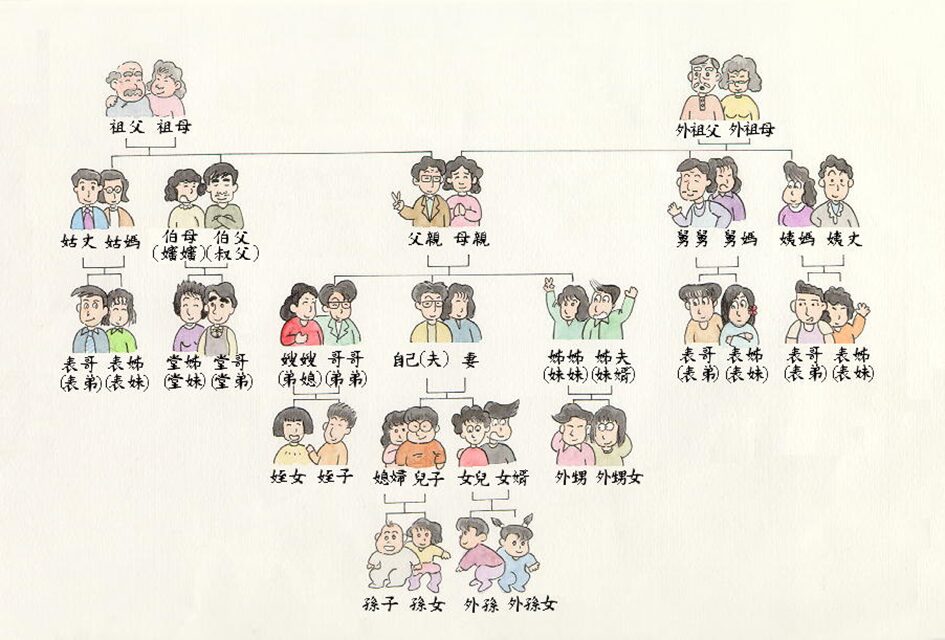
By 2050, around 18 percent of men and women over 60 (all only children) will no longer have any living relatives and will burden society. The first systematic study by the two researchers on the “revolution in families” has now been published. Business-minded Chinese, on the other hand, recognized a market opportunity in the change in family structures. Around the year 2000, 20 years after the start of the one-child policy, the first 亲戚计算器 appeared – kinship calculators, which were soon also available as apps and were marketed as an “absolute must” for young city dwellers for their New Year’s trips home 中国亲戚关系图受网友追捧 被赞 “回家过年必备.
China’s million-strong army of only children, who grew up with only their father, mother and four grandparents, lost their connections to their relatives and did not even learn how to address distant relatives in the traditional way that would not offend them. In Chinese, uncle, aunt, niece or nephew is not enough. There are hundreds of different forms of address 称谓. There are even different titles for younger or older brothers and sisters.
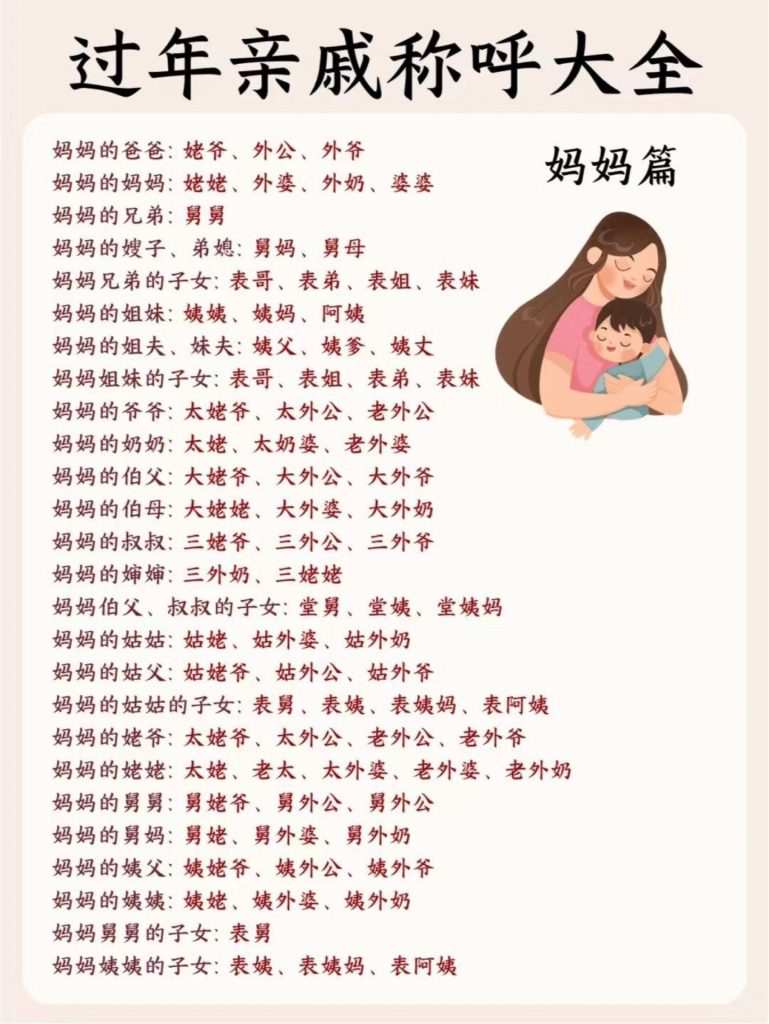
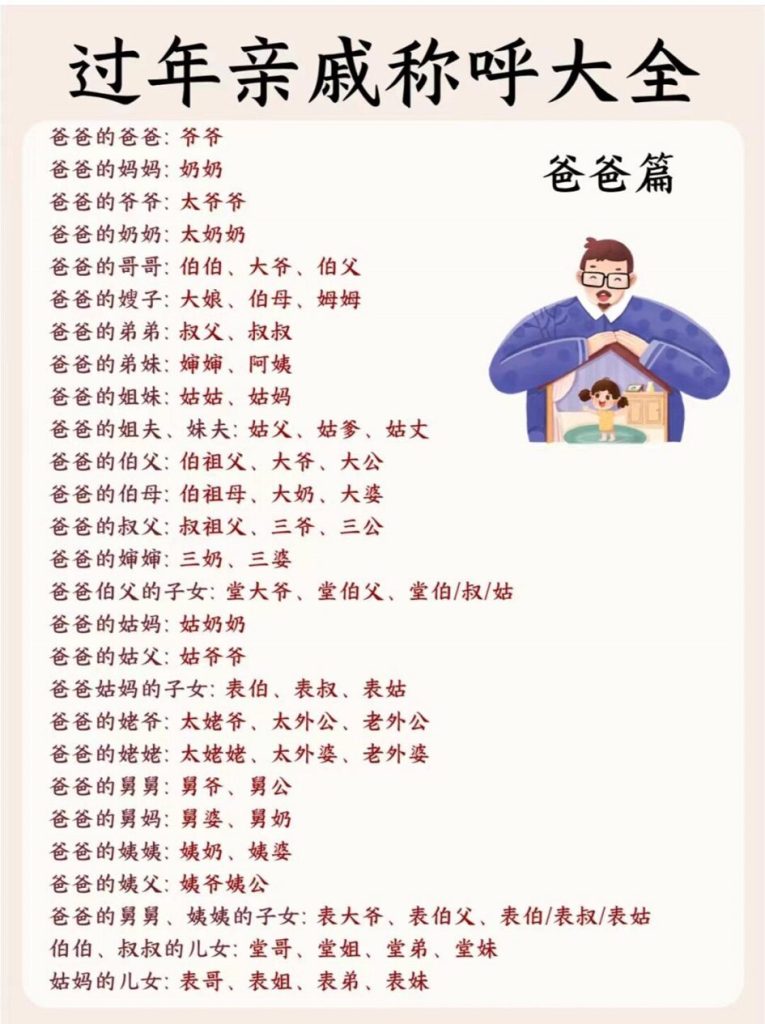
Tables and apps solved the woes of only children, especially during rural visits to the Spring Festival. Within one generation, Beijing’s one-child policy changed society more radically than Mao’s Cultural Revolution ever could. How Beijing’s leadership managed to enforce its dictatorial birth control policy in the post-1980 reform movement is a chapter of China’s party history that has yet to be reappraised and expiated.
Some farmer families resisted this policy. They were popularly known as birth guerrillas 超生游击队. Women who did not report their pregnancies escaped forced abortions by fleeing to relatives in neighboring provinces to have their babies in secret. In Beijing villages, the names and surnames of children such as Sanjian or Wujian (3000 or 5000) revealed to me how much money their parents had bribed population officials with so that their children could be born. In later years, the authorities imposed extreme fines as punishment for second or third births, often equivalent to a year’s income.
Because boys were traditionally “more valuable” to parents than girls for carrying on the family legacy, they were aborted before birth or even killed as newborns. Distorted ratios of 118 boy births to 100 girl births in annual population statistics reveal millions of tragedies. From 2015, Beijing gradually abolished the one-child policy, which had become too successful, first allowing the birth of two children and then three from 2021. Officially, family planning officials claimed that their control had made China’s prosperity possible in the first place. Mathematically, 400 million fewer babies were born in these 35 years.
The Communist Party wants to compensate for the decline in new births, falling growth, and aging through robotization and automation. It relies on economic drivers such as new productive forces, artificial intelligence, and innovation to continue to grow into a superpower.
But this generally requires a young population. When China’s communists celebrate the 75th anniversary of the Socialist People’s Republic on October 1, their billion-strong population will be on its way to halving to the level of China’s early years. But the party itself is growing and growing. On October 1, it will announce a new record: With more than 100 million members, it is the largest Communist Party in the world.
Christian Roettinger has been the Project Lead Vehicle Data Collector at Audi China since August. The electrical engineering and information technology graduate previously worked in Software Development Charging Systems for VW in Suzhou.
Is something changing in your organization? Let us know at heads@table.media!

Visitors to the Hunan Museum in Changsha admire a garment from the Han tombs of Mawangdui. “Thin as a cicada’s wing,” the 48-gram textile is the thinnest and lightest complete garment ever found during archaeological excavations, according to the museum.
The Mawangdui tombs, uncovered between 1972 and 1974, are certainly among the most important archaeological finds in China in the 20th century. Due to the deep location and the hermetic seal, not only pieces of clothing but also entire human bodies have been amazingly well-preserved. The silk-wrapped mummy of the noblewoman Xin Zhui, who died around 160 BC at the age of 50 due to obesity, was also found there. She was so well-preserved and the skin so elastic that scientists were able to extract blood from her veins.
There is actually an arrest warrant against Russia’s President Vladimir Putin from the International Criminal Court. The handcuffs should have clicked during his most recent state visit to Mongolia. Instead, head of state Ukhnaagiin Khürelsükh rolled out a red carpet for his powerful neighbor in Ulaanbaatar. And Putin visibly enjoyed walking across it. A signal to the world that he is not isolated.
However, apart from this small satisfaction, Putin’s visit to Mongolia was not a success, as Michael Radunski writes in his analysis. After all, Putin came to Ulaanbaatar to finally get a commitment from the small neighboring country for his mammoth “Power of Siberia 2” project, a gas pipeline from Russia through Mongolia to China. However, Mongolia is cautious and does not want to increase its dependence on Russia further. And China is also not playing along as hoped: Beijing wants steep discounts on Russian gas.
The one-child policy has been successful, but with an effect that is unlikely to please Beijing. Calculations suggest that China’s population will have halved by the end of the century. What has already largely disappeared is the extended family, once an important bond in society. Even today, young people no longer know how to address distant relatives correctly at family gatherings, writes Johnny Erling in his column. The Chinese language has its own word for every relative: Apps help with the linguistic subtleties.


Vladimir Putin’s visit to Mongolia caused considerable furor. Anger spread, especially in the Western media: “No Arrest, but a Guard of Honor for Putin” was one of the headlines. The reason for this is the arrest warrant against Russia’s president issued by the International Criminal Court (ICC) – and the Mongolian head of state Ukhnaagiin Khürelsükh should actually have had Putin arrested.
All of this is true. Yet the fact that the Russian president’s visit to Mongolia was a substantive failure is being overlooked. Putin’s primary goal in Ulaanbaatar was to advance his enormous “Power of Siberia 2” project, a gas pipeline from Russia via Mongolia to China. However, it failed completely. Mongolia is growing increasingly skeptical about the gas pipeline. And in the background, China is demanding steep price reductions.
In Ulaanbaatar, Putin campaigned extensively for the pipeline: He said that the “Power of Siberia 2” was by no means just about the transit of Russian gas through Mongolia. “We are discussing the potential delivery of gas to Mongolian consumers,” said Putin, according to Kremlin sources – and promised that the Russian company Gazprom was ready to provide the necessary support to connect Mongolian consumers to the gas supply system.
A very tempting offer for Mongolia. The democracy in the Far East is geographically wedged between the autocratic superpowers of Russia and China. Without its own access to the sea, Mongolia’s dependence is almost overwhelming: 98 percent of its energy comes from Russia, while 90 percent of its exports go to China.
And yet, head of state Uchnaagiin Chüreslsüch turned down the Russian offer. “Mongolia has probably realized that this is a poisoned gift from Moscow,” Viktor Frank told Table.Briefings. At the start of the project, the mood was much more positive. “But since the war in Ukraine, the mood has changed. People don’t want to increase their dependence on Russia any further,” explains the head of the Konrad Adenauer Foundation’s office in Ulaanbaatar.
Putin urgently needs success with the “Power of Siberia 2.” Since the Russian invasion of Ukraine and the Western sanctions, Gazprom has had particular problems selling its gas. After the gas company reliably flushed billions into the Kremlin’s coffers, it is suddenly in the red – for the first time since 1999. Last year closed with a record loss of almost 6.4 billion euros.
It needs new buyers. And Putin actually has a plan: The gas that Gazprom used to sell profitably in Europe is supposed to go to China – via the “Power of Siberia 2.” At a cost of around 100 billion euros, the 2,600-kilometer-long pipeline will transport 50 billion cubic meters of natural gas per year from the Yamal Peninsula in the north of Russia via Mongolia to China. Everything could fit perfectly: China’s hunger for energy is enormous. On top of this, the country is currently closer to Russia in its “boundless friendship” against the West than almost ever before in history.
But while Mongolia is increasingly skeptical about the project, China is now also limiting this friendship – over money. Beijing wants to pay the same price for Russian gas as Gazprom charges on the domestic market. Gas is significantly cheaper for Russian customers because it is massively subsidized by the state.
Another fact shows just how unfriendly Beijing’s demands are: China is already paying significantly less for Russian natural gas than Gazprom was previously able to demand from European customers such as Germany. Li Lifan, an expert on Russia and Central Asia at the Shanghai Academy of Social Sciences, explains China’s position in the South China Morning Post as follows: “Mongolia hopes to get investment from China and Russia, [but] Russia does not have the money and China is not in a rush to build the pipeline.” Viktor Frank from the KAS in Ulaanbaatar is also convinced: “The decisive factor is China. If Beijing gives the go-ahead, the pipeline will be built.”
In any case, Mongolia has already drawn the consequences. The ruling government coalition has removed the “Power of Siberia 2” from its action program for the next four years. And so Putin’s supposed diplomatic success in Ulaanbaatar is fading very quickly.
And about the arrest warrant? It’s true: Since March 2023, the International Criminal Court (ICC) has issued an arrest warrant for Russia’s president. Since Mongolia has ratified the Rome Statute of the ICC, the Mongolian head of state should have had Putin arrested. That did not happen, and Putin clearly enjoyed showing the West in Ulaanbaatar that he is by no means as isolated as they would like him to be. But that was about the only thing he achieved in Mongolia.
Sept. 16, 2024; 3 p.m. CEST (9 a.m. Beijing time)
Center for Strategic and International Studies, online seminar: A New Cold War? Congressional Rhetoric and Regional Reactions to the U.S.-China Rivalry More
Sept. 17, 2024; 11 a.m. CEST (5 p.m. Beijing time)
Sino-German Center Frankfurt School, Virtual Roundtable: Development and Future of Corporate Venture Capital in China More
ept. 18, 2024; 7 p.m. CEST
Merics and Young China Watchers, Seminar with personal invitation (in Berlin): Oxford-style Debate: Be careful what you wish for! Trump or Harris – Who is better for European China Policy? More
Sept 19-28, 2024
AHK China, Radisson Collection Hotel, Event (in Shanghai): 25th Shanghai Oktoberfest More
Sept. 20, 2024; 8:30 a.m. Beijing time
AHK China, lecture and networking event (in Beijing): Sino-German Automotive Forum: Driving The Green Transformation More
Showdown on additional EV tariffs: China’s Minister of Commerce Wang Wentao will visit Brussels next week. The Chinese Ministry of Commerce announced on Thursday that Wang will meet EU Trade Commissioner Valdis Dombrovskis next Thursday to discuss the tariffs.
The decision on whether the additional tariffs on Chinese EVs will apply for five years from November will be made in the coming weeks – but the rift between the EU states is becoming clearer. Spain’s Prime Minister Pedro Sánchez spoke out against the tariffs during his visit to Beijing this week and German Chancellor Olaf Scholz expressed a similar sentiment.
At the upcoming binding vote in the EU Council, 15 of the 27 member governments, representing 65 percent of the population, would have to vote against the tariffs to prevent them from coming into force for five years as planned. In a preliminary vote in July, Spain had still voted in favor of the tariffs – but Beijing’s subsequent threat to impose anti-dumping duties on pork apparently had an effect on Spain, the EU’s largest producer.
Germany and several other member states had abstained. It remains to be seen whether Spain will actually vote against the tariffs. However, if this is the case, there is still a long way to go before the tariffs are stopped, according to the Council’s assessment. Several populous member states would have to switch to the camp opposed to the tariffs. ari/mgr
German Environment Minister Steffi Lemke has announced at a hearing in the Bundestag’s Environment Committee that the projects involving climate certificate fraud in China will be reversed. Wherever possible under administrative law, the damage caused to the climate must be compensated, Lemke explained at a special session of the Bundestag’s Environment Committee on Wednesday, according to a report by the agricultural service Agra.
According to a report by the Ministry of the Environment, reversing incorrect projects is associated with high legal hurdles, but has already occurred in one case. Lemke testified before the Committee at the request of the CDU/CSU parliamentary group. Members of the CDU/CSU accused Lemke of taking too long to uncover the irregularities.
According to Agra, Lemke stated that her ministry had discontinued the fraud-prone system as of July 1. New applications have not been accepted. On Friday, the Federal Environment Agency (UBA) announced that it had stopped eight so-called Upstream Emission Reduction (UER) projects in China. Several large, internationally active companies had applied for these certificates. They wanted to use them to offset carbon reduction measures in China in order to fulfill their emission quotas. The UBA is currently investigating other projects in China and around the world. According to Lemke, investigations are also underway against German companies allegedly involved in certifying the halted projects. ck
The Chinese Ministry of Commerce has warned the country’s car manufacturers of the risks of investing in foreign automotive markets. At an industry meeting in early July, ministry representatives “strongly advised” local car manufacturers against investing in India, Russia and Turkey, referring to a central government directive, Reuters reported, citing anonymous sources. They also classified the construction of factories in Europe and Thailand as risky, albeit less strongly.
It was said that overseas factories should primarily use components exported from China for the final assembly of vehicles. This would minimize potential risks due to geopolitical problems. Chinese car manufacturers increasingly aim to expand abroad as they struggle with a worsening overcapacity problem.
The presence of Chinese car brands has increased in Russia since Western car manufacturers withdrew due to the war in Ukraine. Chery is currently in talks with Russian manufacturers about local car production, as the state news agency TASS reported in August, citing Vladimir Shmakov, the director of Chery’s Russian subsidiary.
Several European countries, including Spain and Italy, are also trying to attract investment from Chinese car manufacturers. However, Chinese companies remain cautious. Independent local production requires significant investment and a deep understanding of local laws and culture. Nevertheless, Volvo owner Geely is already sounding out locations for a plant in Europe, but has not yet fully committed to setting up local production, according to executives.
Other companies, such as Leapmotor, have opted for a partnership with local firms. This year, Leapmotor’s joint venture with Stellantis began producing electric vehicles at the French-Italian car manufacturer’s Polish plant. rtr

For a long time, the People’s Republic was proud of two unique characteristics: Being the world’s most populous nation and, since 1980, the first country with a population of one billion. However, India caught up with China and overtook it in 2022. Not only do more people live there today, but they are also younger – by ten years on average. By the end of this century, China may no longer be a nation of billions.
Since Tourists are finally allowed to visit the People’s Republic after the pandemic, they gush about the vital society in a modern state that owns the 21st century when they return home. They ignore a reality that Beijing itself calls its second “new norm”: A persistent economic and consumer slump, young people’s fears about the future and a rapidly aging society.
The causes are not only the economic problems exacerbated by the pandemic, but also the long-term consequences of a one-child policy that was enforced for decades. On closer inspection, the outwardly dynamic Middle Kingdom is a gigantic empire of the elderly. In September, its Ministry of Civil Affairs revealed that by the end of 2023, one in five Chinese citizens will be over the official retirement age. In numbers: Around 297 million of the 1.4 billion Chinese will be over 60 by then, including 215 million over 65.

60-year-olds comprise well over 21 percent of the population and 65-year-olds over 15.4 percent. This means that the People’s Republic has made another quantum leap, albeit an unintentional one this time: Catching up with developed countries such as the USA, Europe, Japan or South Korea in terms of population age. According to the UN definition, China falls into the category of a “moderately aged society,” with 15 percent over the age of 65. While it took Europe decades and the USA 66 years to achieve this, the People’s Republic did it in just 25 years.
With its inadequate social security systems and its glaring rich-poor and rural-urban divide, the country is not prepared for this. First, it would have to raise its retirement age, which is currently 60 for men and 50 or 55 for women. The corresponding plan will be on the next People’s Congress agenda. China had set the current retirement age in the Labor Law of 1951, at a time when life expectancy was 43 years. Today, life expectancy is 78.6 years, thanks to improved living conditions during the reform period and advances in nutrition and medicine.
This success has a downside: China’s underfunded pension funds will be empty by 2035, as Beijing economists have repeatedly warned since 2019. Party leader Xi Jinping has set the year 2035 as his target to prove to the world that his People’s Republic has become the most developed industrialized country in the world. For many years, Beijing ignored the fact that the age pyramid in China had tipped more abruptly than in any other country. By 2035, one in three Chinese will be over 60 years old, including one in four over 65. The nationalist party leadership does not yet dare approach the taboo of promoting the immigration of young skilled workers and young talent from abroad.
The public was also unprepared for the latest warning from the United Nations. By 2100, China could face the biggest population decline ever experienced by a country during peacetime. The first signs of declining childbirths are the thousands of school and kindergarten closures nationwide. The causes are home-made. The key factor was over 35 years of enforced birth planning. It accelerated the decline in birth rates far below the level required to sustain the nation. Concurrently, the number of women of childbearing age decreased.

The astonishing scenario is part of current UN forecasts, according to which the world’s population will peak around 2080 – a prospect that has also triggered concerns in the West. The influential journalist Gabor Steingart wrote in his information service “Pioneer”: “We are no longer confronted with a population explosion, but with a global population implosion.” UN projections indicate that by the end of the 21st century, the 1.41 billion Chinese population will have shrunk by more than 700 million people to around half of what it is today.
In January 2023, the National Bureau of Statistics issued its first warning: In 2022, it had only recorded 1.412 billion people, one million fewer than in 2021. One year later, it was two million fewer people. No wonder, as the total number of births in China had now fallen to nine million babies, the lowest level since 1949. This was accompanied by reports of a declining working population between the ages of 16 and 59, especially among the youth.
As a result of the one-child policy, “radical and historically unprecedented changes” in Chinese families are now becoming apparent, from the replacement of traditional extended families by hundreds of millions of nuclear families to the dissolution of traditional kinship structures, wrote the US population researcher Nicholas Eberstadt and sociologist Ashton Verdery in 2023. Beijing’s politicians only focused on data about men and women in censuses, but ignored the changes in family groups and the “atrophy” of the kinship network, one of the sources of Chinese stability.

By 2050, around 18 percent of men and women over 60 (all only children) will no longer have any living relatives and will burden society. The first systematic study by the two researchers on the “revolution in families” has now been published. Business-minded Chinese, on the other hand, recognized a market opportunity in the change in family structures. Around the year 2000, 20 years after the start of the one-child policy, the first 亲戚计算器 appeared – kinship calculators, which were soon also available as apps and were marketed as an “absolute must” for young city dwellers for their New Year’s trips home 中国亲戚关系图受网友追捧 被赞 “回家过年必备.
China’s million-strong army of only children, who grew up with only their father, mother and four grandparents, lost their connections to their relatives and did not even learn how to address distant relatives in the traditional way that would not offend them. In Chinese, uncle, aunt, niece or nephew is not enough. There are hundreds of different forms of address 称谓. There are even different titles for younger or older brothers and sisters.


Tables and apps solved the woes of only children, especially during rural visits to the Spring Festival. Within one generation, Beijing’s one-child policy changed society more radically than Mao’s Cultural Revolution ever could. How Beijing’s leadership managed to enforce its dictatorial birth control policy in the post-1980 reform movement is a chapter of China’s party history that has yet to be reappraised and expiated.
Some farmer families resisted this policy. They were popularly known as birth guerrillas 超生游击队. Women who did not report their pregnancies escaped forced abortions by fleeing to relatives in neighboring provinces to have their babies in secret. In Beijing villages, the names and surnames of children such as Sanjian or Wujian (3000 or 5000) revealed to me how much money their parents had bribed population officials with so that their children could be born. In later years, the authorities imposed extreme fines as punishment for second or third births, often equivalent to a year’s income.
Because boys were traditionally “more valuable” to parents than girls for carrying on the family legacy, they were aborted before birth or even killed as newborns. Distorted ratios of 118 boy births to 100 girl births in annual population statistics reveal millions of tragedies. From 2015, Beijing gradually abolished the one-child policy, which had become too successful, first allowing the birth of two children and then three from 2021. Officially, family planning officials claimed that their control had made China’s prosperity possible in the first place. Mathematically, 400 million fewer babies were born in these 35 years.
The Communist Party wants to compensate for the decline in new births, falling growth, and aging through robotization and automation. It relies on economic drivers such as new productive forces, artificial intelligence, and innovation to continue to grow into a superpower.
But this generally requires a young population. When China’s communists celebrate the 75th anniversary of the Socialist People’s Republic on October 1, their billion-strong population will be on its way to halving to the level of China’s early years. But the party itself is growing and growing. On October 1, it will announce a new record: With more than 100 million members, it is the largest Communist Party in the world.
Christian Roettinger has been the Project Lead Vehicle Data Collector at Audi China since August. The electrical engineering and information technology graduate previously worked in Software Development Charging Systems for VW in Suzhou.
Is something changing in your organization? Let us know at heads@table.media!

Visitors to the Hunan Museum in Changsha admire a garment from the Han tombs of Mawangdui. “Thin as a cicada’s wing,” the 48-gram textile is the thinnest and lightest complete garment ever found during archaeological excavations, according to the museum.
The Mawangdui tombs, uncovered between 1972 and 1974, are certainly among the most important archaeological finds in China in the 20th century. Due to the deep location and the hermetic seal, not only pieces of clothing but also entire human bodies have been amazingly well-preserved. The silk-wrapped mummy of the noblewoman Xin Zhui, who died around 160 BC at the age of 50 due to obesity, was also found there. She was so well-preserved and the skin so elastic that scientists were able to extract blood from her veins.
